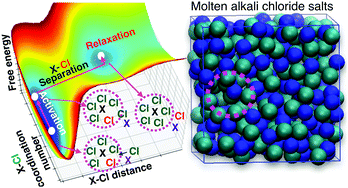Structure and dynamics of the molten alkali-chloride salts from an X-ray, simulation, and rate theory perspective†
Abstract
Molten salts are of great interest as alternative solvents, electrolytes, and heat transfer fluids in many emerging technologies. The macroscopic properties of molten salts are ultimately controlled by their structure and ion dynamics at the microscopic level and it is therefore vital to develop an understanding of these at the atomistic scale. Herein, we present high-energy X-ray scattering experiments combined with classical and ab initio molecular dynamics simulations to elucidate structural and dynamical correlations across the family of alkali-chlorides. Computed structure functions and transport properties are in reasonably good agreement with experiments providing confidence in our analysis of microscopic properties based on simulations. For these systems, we also survey different rate theory models of anion exchange dynamics in order to gain a more sophisticated understanding of the short-time correlations that are likely to influence transport properties such as conductivity. The anion exchange process occurs on the picoseconds time scale at 1100 K and the rate increases in the order KCl < NaCl < LiCl, which is in stark contrast to the ion pair dissociation trend in aqueous solutions. Consistent with the trend we observe for conductivity, the cationic size/mass, as well as other factors specific to each type of rate theory, appear to play important roles in the anion exchange rate trend.

- This article is part of the themed collection: 2020 PCCP HOT Articles


 Please wait while we load your content...
Please wait while we load your content...